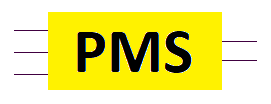The State Diagram Editor SD2

The user interface of the state diagram editor PMS-SD2 with an example program
What are the benefits using States ?
Each controller is at different times in a specific state. When a Power-On-Reset, a Pin-Reset or a SW-Reset is released, in the Startup-State the Main-Routine is started, where all basic initializations are done. Here the cyclic progression is initialized by the internal timers and the idle endless loop is started, which then steadily runs in the background.
The Run-Event then triggers the Run State. In the Run State a Flash Diagnose Message for example triggers the flash event. In the Flash state all messages, which have nothing to do with the flashing, would only disturb. This is why they are all deactivated. When the flashing is finished, the software in the flash state finally triggers the Run-Event.
Every industrial production machine must in certain steps repeat specific actions. PLC programmers call this procedure sequence chains. For this State Diagrams are very helpful.
For what is the Sleep-State used for ?
A car for example stands inactive around for typically 23 hours each day. When the dashboard controller senses an inactive state, it will release the prepsleep event in all controllers of the car by a diagnostic broadcast message to start the Doze State in all car controllers. The complete electric system of the car is set into the sleep state to drastically reduce the power consumption of the car. In the Sleep State the power consumption of all controllers will then by only be a few nano Watts. This will reduce the electric power consumption by a factor of about 100.
Because in the Sleep-State the controller RAM is not fed, all data will be lost. To prevent this, in the Doze and Wake States all data of the error memory and other data are written or read to/from a nonvolatile memory.
The Highlights of the PMS State Diagram Editor SD2
The PMS State Diagram editor SD2 offers the graphical programming of measurement and control applications in the popular state diagram presentation. With SD2 you easily can program state diagrams, just by drawing states, events, actions and comments from the toolbox and place them on your worksheet. When you save your state diagram C, C++ or C# source code is created.
Your state diagram also will appear in the toolbox of the StandOS Configurator, so you can place them in the drivers and applications of your microcontroller software architecture.
SD2 offers the big advantage of a target independent programming. The target hardware can be a PC/IPCs, an embedded controller equipped by the StandOS operating system, the 19" rack system PMS-RACKSYS or the industrial PLC PMS-ARCON.
With PMS Universal Programming Studio you can build and download and then run your program on the target hardware. The state diagram program can be visualized and controlled online and in real time via LAN, WAN, CAN and LIN or it can be simulated on the PC. The target software can be debugged and single stepped in the target hardware and all process data can be read and written in the watch window.
Highlights of the State Diagram Editor SD2
· Programing and documentation in one step
· Automatic creation of highly efficient real time C, C++ or C# code
· Simulation of State Diagrams directly in the editor
· Online run of State Diagrams directly in the editor
· Cut, copy and paste of all objects of State Diagrams
· Unlimited undo and redo functionality
· Full flexibility editing, for example move, insert and delete
· The build-in syntax check and finds errors automatically
· Comments can be placed freely everywhere
· Printing on DIN-A4 and DIN-A3 pages, landscape or portrait, with preview
· Reference list for all symbolic names of variables
· All object sizes, object colors, text fonts and many other properties can easily be set
· User interface with menus, icons and context menus
· Up-to-date sophisticated context sensitive help with contents and indexes
